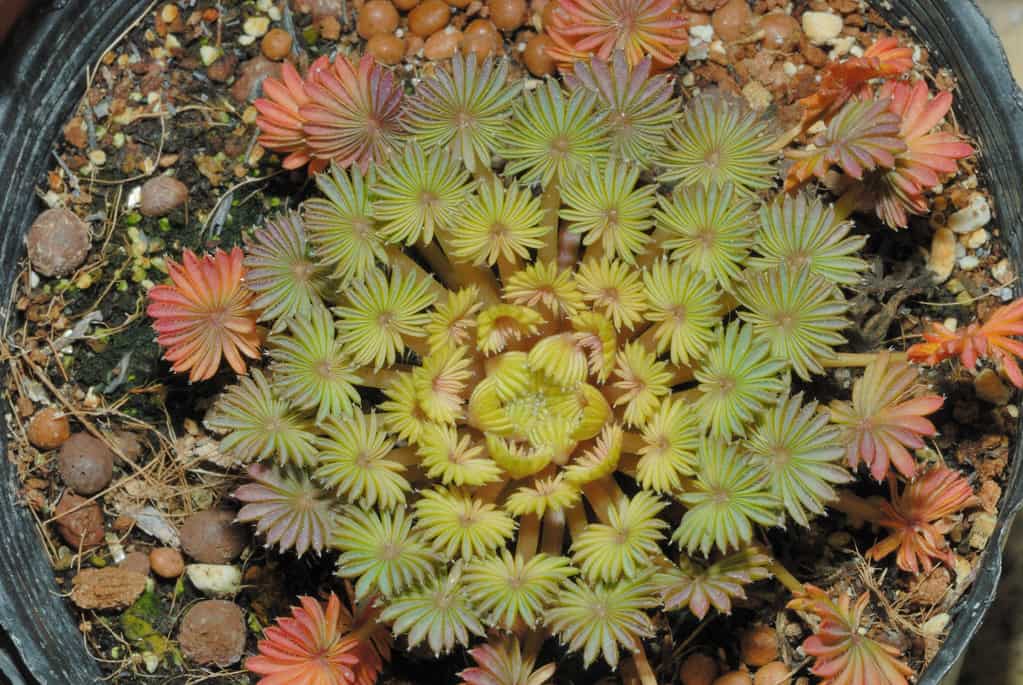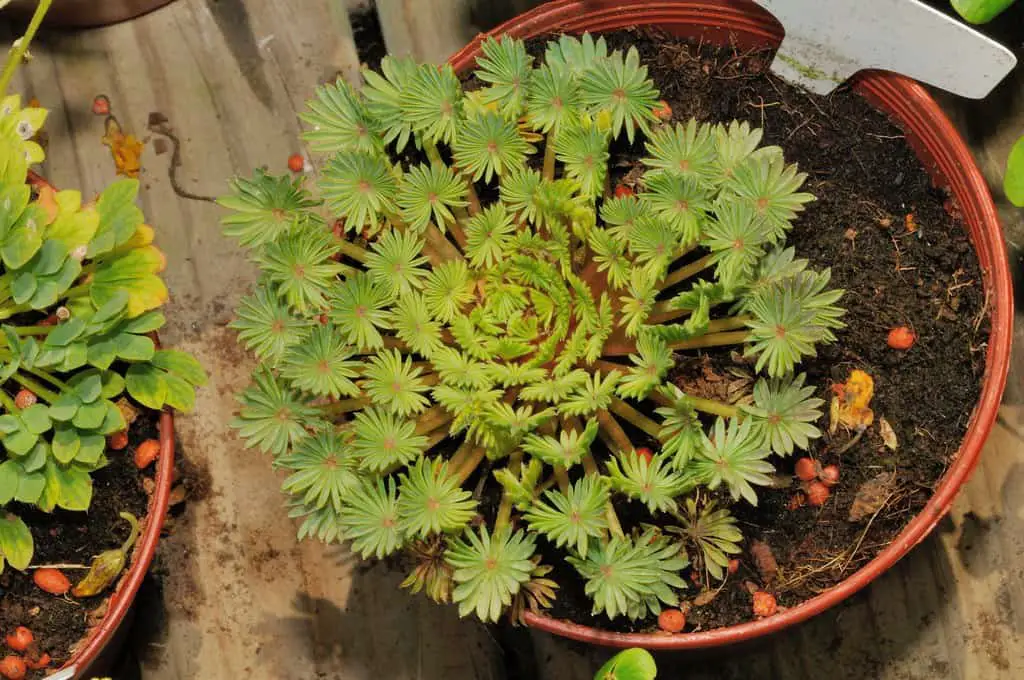What is Oxalis palmifrons? Oxalis palmifrons is commonly known as Palm-leaf False Shamrock, False Shamrock, or Palm Leaf Oxalis. The family and genus of the plant are Oxalidaceae and Oxalis respectively. The origin of Oxalis palm frons is in the deserts of western Karroo in South Africa. Oxalis palmifrons aka Palm Leaf Oxalis is a succulent plant that belongs to the famous Oxalis succulents plant category.
In reality, Oxalis palmifrions is one of the most glorious plants of natural beauty, native to South Africa, where it is going dormant during the summer and comes to life during the winter months. These succulents plants only can be seen in wintertime with beautiful foliage. Oxalis palmifrions is rise very low on the ground, never reaching a height of more than a few centimeters (7.5 cm).
The leaves are normally greenish color, fading at the edges of the rosette to pink shades, then to a deeper purple. From a central point, perfectly fan-shaped leaves stretch out and fold up at night, reopening throughout the day. This is generally a bulb that during the summer goes dormant, and when the weather cools down a little, the new leaves appear. To grow well and yield a flower, this plant requires bright indirect light.
How to identify Palm-leaf False Shamrock or Oxalis palmifrons?
Palm-leaf false shamrock leaves are small, symmetrical fronds radiating from the top of every other stem, making it look like a tiny cluster of tiny palm trees for the entire world. The color of the Oxalis palmifrons leaves is green and the edges of the rosette are shading with pink and dark purple color. They grow very close to the ground, never growing higher than 7.5 cm. They have spread incredibly steadily in around ten years, reaching a range of 2 feet (60 cm).
Palm-leaf false shamrock is a winter plant and going dormant in hot summer. In the fall this plant starts to emerge and has small light pink flowers, which is a very cute sight to the eye.
How do you take care of Oxalis palmifrons?
-
Size inch and cm
They mature very close to the ground, never reaching 7.5 cm in height. In about ten years, they have spread extremely rapidly, exceeding a range of 2 feet (60 cm).
-
Growth
The growth and spreadability of the Oxalis palmifrons is very very slow and the lifetime of the plant is nearly ten years. These succulents can grow up to 7.5cm in maximum. After maturation of the plant, width is coming near to 2 feet.
-
Light Requirement
the plant can grow best If it gets a few hours of sunshine daily. The afternoon hue is just fine. Quite a tiny Oxalis palmifrons plants should be protected from direct sunlight. The leaves of the Oxalis palmifrons can be wilt due to afternoon sunshine but they will be recovered soon due to cooler temperature on the next day. They require oxygen that circulates freely. Also, in the winter season, it will be blooming frequently if plants can receive sunny spots.
-
Temperature and humidity
Oxalis palmifrons like to live in cold temperatures and this climatic condition enhances the growth of the plant. The best temperatures for the plant between 60 degrees of Fahrenheit to 70 degrees of Fahrenheit (15 degrees of Celsius to 21 degrees of Celsius) during the day and 55 degrees of Fahrenheit to 65 degrees of Fahrenheit (13 degrees of Celsius to 18 degrees of Celsius) at night.
Any amount of humidity would do. The usual humidity of the room is perfect.
-
Is it cold hardy?
Oxalis palmifrons are a cold tender plant and a winter grower. In the cold temperatures, the plant on the pot performs well which is near the window. If the winters get harsh, bring it indoors, and don’t give up on it as it disappears with the summer.
Zone
The Hardiness zone of Oxalis palmifrons is 7b to 11b: from 5 degrees of Fahrenheit (-15 degrees of Celsius) to 50 degrees of Fahrenheit (10 degrees of Celsius).
(A hardiness zone is a geographically defined region in which, as defined by climatic conditions, a certain type of plant life is able to expand, including its ability to withstand the minimum temperatures of the zone)
Watering Requirement
The water requirement of the Oxalis palmifrons is regular, but not too much.
Before watering, the top (2 inches/ 5 cm) of the soil should be dried and leaving the soil of Oxalis palmifrons plant should be wet slightly but it should not be soggy. It is easier to water the Oxalis palmifrons from the bottom so that the plant’s small, delicate stems do not get waterlogged and the soil remains loose.
Soil Requirement Type / pH
Oxalis palmifrons requires a very well-drained mix and slightly acidic soil. In addition, prior to planting, enhance soil quality and irrigation by mixing in a little well-rotted manure or compost. Be cautious not to position the plant in an environment that is water-accumulating. A deep pot might be required.
Flowering and Fragrance
Oxalis palmifrons contain flowers topped with pink color and the plant is a winter grower and it is going to be dormant in the summer.
Pot size
Pot size of Oxalis palmifrons is 2.5’’ (7.9 fl oz/233 ml). The plant does not require a wide pot, since its size is very small and lightweight.
Where to Plant
Oxalis palmifrons plants can be grown indoors in the garden as a domestic plant or outdoors. On the other hand, In the winter, Oxalis palmifrons plants should be kept indoors. Enough sunlight, mildly sandy and acidic soil and watering from the bottom of the container facilitate the growing of the plant.
Fertilizer and time of year
Fertilize should be done in the growing season of the Oxalis palmifrons. You can used half the amount/strength of fertilizer with a normal plant. During the dormant stage of Oxalis palmifrons, never feed the plant until it is ending its dormancy period.
Dormancy
Throughout the summer, the plant is dormant and develops through winter, with the leaves appearing in late autumn. When the plant goes dormant, bright light, water and little amounts of fertilizers can be supplied.
Can be toxic to pets
If enough is eaten, all plants containing oxalic acid can be poisonous to humans. Also, it can be toxic to pets like dogs and cats.
Common bugs and ILLNESS ISSUES
Color of the leaves of Oxalis palmifrons changed to yellowish color and mushy stems can be seen due to overwatering or root rot. Due to underwatered and low humidity wilting brown leaves and crispy edges can be seen.
Special Care tips
If it gets spider mites, treat the plant with weekly sprays of horticultural (neem) oil and daily wipe-downs of the plant as soon as they emerge. When plant goes dormant, bright light, water and little amounts of fertilizers can be supplied.
Credits to 澎湖小雲雀
How do you propagate Oxalis palmifrons?
By the seed, separating bulbous offsets or dividing from plant, you have a fair chance of successfully propagating just about every member of this genus.
From seeds
- Oxalis palmifrons Seeds Sow – Place seeds 1 inch apart in a sunny or partially shaded garden bed on the bottom.
- O.palmifrons Seeds Cover with soil – you should press the seeds of Oxalis palmifrons into the soil, softly. so that nearly one eighth of an inch of soil is barely covered.
- Oxalis palmifrons Seeds germination Encourage – Water the region and keep the seeds of oxalis moist until they germinate. Once germination occurs.
Green shoots can be identified from the ground. During the first growing season watering should be done to moist the bed.
From separating bulbous offsets
Dig up the clump in the summer by placing the shovel on the ground 4 inches from the clump’s base. The main root mass is then drilled down to the bottom.
- Excess soil removes
- To expose the bulbous stems, raise the plants from the ground and dust off excess dirt.
Bulbous roots remove
Using your thumbs, tear apart the bulbous tips.
Oxalis palmifrons replant
Replant each oxalis in 2-inch diameter or larger pot filled with normal potting soil or out in the field in partial shade to a warm area. Set the plants in such a way that the bulbous roots and white base of the stem are covered with soil and the green stem portion is exposed. After you finish the process of planting, water.
From dividing an Oxalis palmifrons plant
A mature Oxalis palmifrons plant Select/ find – In the summer, find a suitable 6-to8-inch or greater Oxalis palmifrons plant.
Oxalis palmifrons plant divide – Set the head of the tool four inches from the base of the stalks on the field and then move it around eight to twelve inches deep beneath the stems.
Oxalis palmifrons remove– Push the shovel out, raising the clump of oxalis from the surface.
The Rhizome Mass separate – Take out the rhizome mass to create multiple sections. You can make the divisions thin, or make them as large as you want the new plants to be, as long as each section has a piece of rhizome root and a green, growing stem.
The divisions transplant – Dig a crater to the same level as the roots where the divisions will be transplanted, plants irrigate. Fill the jars with normal potting soil one inch wider in diameter than the root segment to transplant oxalis into pots. Using pots for nurseries that have drain holes in the rim.
The transplant irrigates – Immediately after replanting, water the freshly transplanted oxalis until the soil is uniformly moist, 6 to 8 inches thick. ·Water the freshly potted parts until the potting soil is moist all the way through the jar.
Ongoing care – When the soil begins to feel slightly dry during the first growing season after transplanting oxalis, water
Oxalis palmifrons plant benefits
Kids enjoy oxalis, both because of the beautiful flower and because of the sour taste of its edible stems. A food source for wildlife is oxalis bulbils. Actually, Oxalis is an outstanding bee and butterfly plant. When blooming, it provides “copious nectar”.Because it doesn’t set seed, it doesn’t benefit from bees, but it is a food source for honey bees, honey bees and butterflies.
Is Oxalis palmifrons an indoor plant?
Oxalis can be grown indoors in the garden as a domestic plant or outdoors. In the fall or early spring, they are effectively available from the garden center.
Do Oxalis palmifrons need direct sunlight?
To grow well and produce flowers, these plants need bright indirect light. If kept in a sunny spot, they can often bloom all winter.
Read more Crassula Springtime Succulent Care 18 Things Must Know


